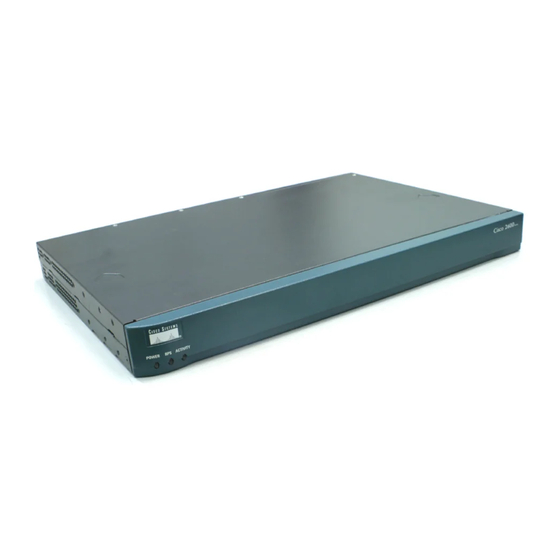Cisco 2651XM - VPN Bundle Router Информационный лист - Страница 5
Просмотреть онлайн или скачать pdf Информационный лист для Сетевой маршрутизатор Cisco 2651XM - VPN Bundle Router. Cisco 2651XM - VPN Bundle Router 11 страниц. Non-proprietary security policy
Также для Cisco 2651XM - VPN Bundle Router: Операции (25 страниц), Руководство пользователя (48 страниц)

All contents are Copyright © 1992–2007 Cisco Systems, Inc. All rights reserved. This document is Cisco Public Information.
TBR-13
●
ETS 300011
●
ITU I.431
●
IP Media Support
T1
●
E1
●
Ethernet, Fast Ethernet, Gigabit Ethernet
●
ATM over T1, E1, OC-3 single mode, OC-3 multimode
●
V.35
●
Note:
SS7 over IP (SCTP, M2PA, M3UA, SUA) is supported over T1, E1, Ethernet, Fast
Ethernet, Gigabit Ethernet, and ATM OC-3 single mode and ATM OC-3 multimode. Support for
other media types can be considered upon request.
Capacity and performance notes:
Cisco 7507 and 7513 Router capacity and performance are based on:
●
Configured with RSP16 and VIP6-80 processors
◦
MTP3 offload and xUA SCTP offload enabled
◦
Dual Route Switch Processor (RSP) for redundancy
◦
One IP VIP interface for network management
◦
This results in four available slots for interface processors on the Cisco 7507 and 10
available slots for interface processors on the Cisco 7513.
Each VIP must be dedicated to a single signaling protocol (Low Speed Link [LSL], High
●
Speed Link [HSL], M2PA, M3UA, or SUA).
Individual links are capable of running at 1.0 Erlang.
●
Performance data listed in Table 4 is based on 100-byte average message signal unit
●
(MSU) size.
For the purposes of estimating MSUs-per-second performance, a packet that enters and
●
then exits the ITP is counted as a single MSU (not as two MSUs). Performance data in
Table 4 reflects this methodology.
For Cisco 7500 Series capacity planning, the rate of MSUs per second cannot exceed the
●
VIP line card or the central processor's MSUs-per-second capacity limits; for capacity
planning on the other platforms, the rate of MSUs per second cannot exceed the central
processor's MSUs-per-second capacity limits.
Multilayer routing introduces a typical 10 percent processor overhead. As the multilayer
●
routing requires the central RSP processor for routing, the feature is not compatible with the
High-Performance VIP-offload feature, which provides increased MSUs-per-second
capacity. The VIP offload NSO feature, however, is supported with multilayer routing.
GTT introduces up to 20 percent processor overhead. This applies to the Cisco 2651
●
Router. With VIP-offload enabled on the Cisco 7500 Series, this overhead only applies to
the M3UA and SUA signaling gateway protocols.
For GSM TCAP-segmented messages that require MO-Proxy for MLR operations,
●
extrapolation based on the percentage of traffic that requires MO-Proxy is used to estimate
Data Sheet
Page 5 of 11
